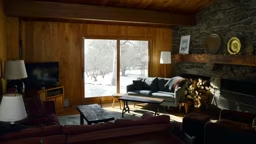
Article courtesy of Garden Gate Magazine
Finishing Outdoor Furniture
Whether you built it yourself or purchased it unfinished, you’ll want to take the time to apply a finish to your wooden outdoor furniture before using it. Not only will a finish make the furniture look better, but it will also protect the wood from water, sun and general wear-and-tear.
You have three options when it comes to finishing: Paint, spar varnish or penetrating oil. No one option is right for every project or every yard — they all have benefits and drawbacks — but each of them will leave your furniture looking good and have it well-prepared for a summer of outdoor adventures.
See also DIY: Build Your Own Adirondack Chair
Paint
Latex paint is often used as a cosmetic fix — to add color, to hide flaws. But when it comes to outdoor furniture, a good layer of paint offers almost unbeatable UV and water protection. And with thousands of colors available, you can turn any piece of furniture into a work of art.
Pros: Paint is available in any color you can imagine, which means painted furniture is guaranteed to match or complement your outdoor décor. It provides superior protection against damaging UV light and it forms a water-tight barrier against moisture. And unlike penetrating oils and spar varnishes, paint gives you a finish that lasts for years without needing a whole lot of maintenance.
Cons: There’s a lot to be said for the look of natural wood, and you lose that completely when you paint. And while a good paint job can last for years, doing it the right way takes time.
How to apply it
Start by applying a single coat of penetrating oil to the project for extra protection against water and sun damage. (For instructions, read “Penetrating oil”, right.) Give the oil 2 or 3 days to really sink into the wood, and then, just as if you were painting your kitchen walls, lay down a good coat of primer over everything. Choose a primer that’s oil-based — it’ll provide the best water resistance. Once the primer has dried (it’ll feel dry to the touch after a few hours, but it’s best to let it set overnight), then it’s time to paint. Go with an exterior latex paint, and apply two coats. Let the furniture dry at least 24 hours after the last coat of paint. After that, your project is ready to sit outside!
Eventually, you may notice that your painted project has started to flake and fade. To bring it back to its former glory, gently remove any chipping or flaking pieces of paint with a wire brush. Sand down the project with medium-grit sandpaper, wipe off dirt and dust, and then add primer (if there are large areas of exposed wood) and repaint. When it’s dry, you’re done!
See also The Best Air Conditioner For Your Cabin this Summer
Spar Varnish
Spar varnish is a polyurethane finish originally developed to protect wooden ships from the harsh conditions out at sea. It’s a film finish, which means that it forms a clear, hard barrier on top of the wood, rather than soaking into the wood like an oil. If you have trouble finding “spar varnish,” look for marine varnish or spar urethane — they’re just different names for the same thing.
Pros: Spar varnish forms a thick, waterproof film over the top of wood. It’s more flexible than other film finishes, so it can handle the wood’s natural expansions and contractions. It has UV inhibitors to protect projects from the harsh sun. It forms a clear, glossy finish that can be used over stained wood.
Cons: Because spar varnish forms a hard film on top of the wood, it will show wear by chipping and peeling off. The varnish’s UV inhibitors lose effectiveness over time, and applying and refinishing it can be time consuming.
How to apply it
The application process is pretty simple, but for reliable protection, you’ll want two or three coats of varnish. Start with a clean paintbrush, and add a thin, even coat of varnish to the furniture, then let it dry. It’ll feel dry to the touch in 6 hours, but give it 24 hours in a protected area before moving on. Before adding the second coat, lightly sand the finish with medium-grit sandpaper — you just want to give the next coat something to grab on to. Wipe off the sanding dust with a dry cloth, and brush on another coat of varnish. Let it dry 24 hours. Repeat the process for a third coat, or start using your new furniture!
For the easiest maintenance, add a new coat of spar varnish each year, before the project actually needs it. Lightly sand down the old finish, wipe it clean, and apply a new coat of varnish. Let it dry for 24 hours, and you’re back in business.
See also How to Update a Worn-Out Deck
Penetrating Oil
Penetrating oils are sort of like protective wood stains. After two or three coats, the oil prevents wood from absorbing moisture and provides a barrier against UV light. And the oil is available in natural-looking colors (like transparent cedar, right) or in clear, which lets wood weather to gray while still being protected.
Pros: Projects treated with penetrating oils are water-repellent and UV-protected. These oils won’t leave a film, which means the finish won’t chip or peel. Refinishing is a snap.
Cons: You may need two or three coats of oil to get the color as dark and rich as you want. While the finish technically can last up to two years, you’ll probably see signs of wear and have to refinish every year.
How to apply it
Before you get started, test the oil on a spare piece of wood to gauge its color and determine how many coats you’ll need. When you’re ready to finish your project, apply a solid coat of oil over everything with a regular paintbrush. Let the oil soak in for 20 to 30 minutes. The end grain will soak up oil faster than the rest of the wood, so check back every few minutes to add more finish there. Once the oil has almost entirely soaked in, wipe off any excess, and if necessary, repeat the process. When you’re satisfied with the color, let the whole thing dry overnight (if not longer).
Projects finished with penetrating oils will probably need to be touched up each year. Sand out any scratches on the furniture, and clean off dust and dirt with a cloth. Apply a new coat of penetrating oil, just like you applied the original coat, and let it dry overnight. That’s it!










